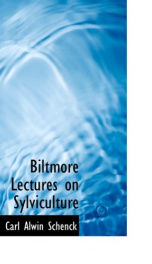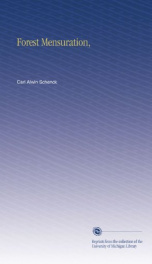biltmore lectures on sylviculture

SYNOPSIS OF PARAGRAPHS. I. Introduction. CHAPTER I. Foundations of Sylviculture. II. Ecological factors and their influence on the sylva. III. Influence of the sylva on the ecological factors. IV. The North American sylva. V. General definitions and explanations.. VI. Light demanders and shade bearers. VII. Pure versus mixed woods. J VTII. Dr. Henry Mayrs fundamental principles of sylviculture. CHAPTER II. The High Forest. IX. Genesis of the high forest and its methods. X. The seed. XI. Preparations for planting seed on open ground. XII. Securing and preparing the seeds. XIII. Actual planting of seeds on open ground. XIV. Season for planting seeds on open ground. XV. Auxiliaries to seed planting. XVI. Planting seeds of the broadleaved species. XVII. Planting seeds of the coniferous species. XVIII. Actual planting of seedlings Introductory remarks. XIX. Criteria of good seedlings. XX. Age, size and number of seedlings used. XXI. Lifting seedlings from nursery bed. XXII. Transportation of seedlings. XXIII. Common methods of planting seedlings in the open. XXIV. Special methods and tools used for planting seedlings in the open. XXV. Season for planting seedlings. XXVI. Cultivation of plantations. XXVII. Prairie planting in particular. XXVIII. Methods of obtaining plants for planting. 3 SYLVICULTURE. XXIX. Permanent nurseries in particular. XXX. Seed planting in seed beds. XXXI. Transplanting in transplanting beds. XXXII. Protection of nurseries. XXXIil. Nursing in nurseries. XXXIV. Special nursery methods proclaimed by renowned sylviculturists. XXXV. Raising and planting hardwood seedlings on open ground. XXXVI. Raising and planting softwood seedlings on open ground. XXXVII. European results of planting experiments with American hardwoods. XXXVIII. European results of planting experiments with American softwoods. XXXIX. Difficulties of natural seed regeneration Enesar-. XL. Age of trees fit for natural seed regeneration Enesar. XLI. Methods of natural seed regeneration Enesar. XLII. Types in which lumbering precedes natural seed regenera- tion. XLIII. Cleared compartment type. XLIV. Cleared strip type. XLV. Cleared group type. XLVI. Cleared selection type. XLVII. Types, in which lumbering coincides with natural seed regeneration. XLVIII. Shelterwood compartment type. XLIX. Shelterwood strip type. L. Shelterwood group type. LI. Shelterwood selection type. L1I. Types in which lumbering follows natural seed regenera- tion. LIII. Advance growth compartment type. f LIV. Advance growth strip type. LV. Advance growth group type. LVI. Advance growth selection type. LVII. Regeneration of valuable species by natural seed regeneration with, amongst and into companions of weedy character. LVIII. Pedagogy of the high forest. LIX. Cleaning in high forest. LX. Weeding in high forest. LXI. Improvement cutting in high forest. SYLVICULTURE. LXII. Thinning in high forest. LXIII. Pruning in high forest. LXIV. Underplanting in high forest. LXV. Key to the forms of high forest. LXVI. Critical remarks on high forest. LXV1I. High forest by species. CHAPTER III. The Coppice Foiest. LXVIII. Genesis of the coppice forr,t. LXIX. Pedagogy of the coppice forest. LXX. Key to the forms of coppice forest. LXXI. Critical remarks on coppice forest. LXXII. Coppice forest by species. CHAPTER IV. The Coppice Under Standards Forest. LXXIII. Genesis of coppice under standards. LXXIV. Pedagogy of coppice under standards. LXXV. Key to the forms of coppice under standards. LXXVI. Critical remarks on coppice under standards. LXXVII. Coppice under standards by species. CHAPTER V... --This text refers to an alternate Paperback edition.
Info about the book
Author:
Series:
Unknown
ASIN:
B006KO0HLC
Rating:
3/5 (3)Your rating:
0/5
Languge:
English
Users who have this book
Users who want this book
What readers are saying
What do you think? Write your own comment on this book!
write a commentif you like biltmore lectures on sylviculture try:
Do you want to read a book that interests you? It’s EASY!
Create an account and send a request for reading to other users on the Webpage of the book!



